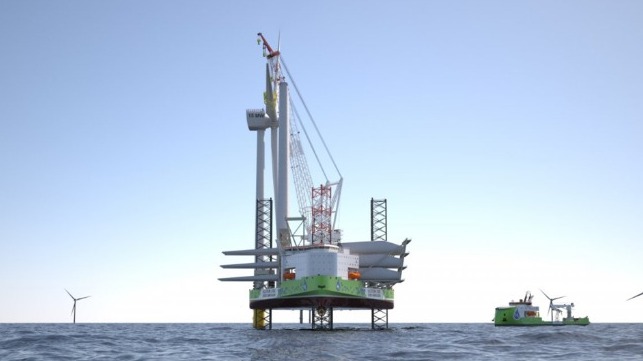Design for Zero Emission Hydrogen Wind Turbine Installation Vessel

Looking to create major advancements in the environmental performance of wind turbine installation vessels, Norwegian shipbuilder Ulstein announced its second hydrogen hybrid design for the offshore wind industry.
Using available technologies, the ULSTEIN J102 zero-emission wind turbine installation vessel (WTIV), can operate 75 percent of the time in zero-emission mode. Further, Ulstein says it is possible to build the vessel using readily available technology with the additional cost limited to less than five percent of the total CAPEX.
According to Ulstein, most new jack-up designs feature a battery hybrid system in addition to diesel gen sets, with a future option for a hydrogen-powered fuel cell system. However, they say the downside of a high-power battery energy storage system (BESS) is its heavy weight and cost. That is not beneficial for a WTIV design they say. Pointing out that weight savings are essential for minimizing elevated weight and optimizing the variable deck load.

that matters most
Get the latest maritime news delivered to your inbox daily.
Rather than opting for technology to be matured to perfection and make a design that is prepared for future hydrogen-powered fuel cells, Ulstein says it has taken a pragmatic, yet realistic approach. “We have carefully analyzed the operational cycle of WTIVs and looked at the power demand in the various modes of operations,” says Ko Stroo, Product Manager at Ulstein. “This analysis showed that approximately 75 percent of its time, a WTIV is in a jacked-up position performing crane operations. Using a combination of a hydrogen fuel cell system and a relatively small battery energy storage system (BESS) is then sufficient to meet the overall power demand on board and crane peak loads.”
The hydrogen hybrid system of the ULSTEIN J102 design has been developed to make it possible to incorporate future developments in hydrogen technology without major modifications to the vessel. “The limited availability of hydrogen bunker infrastructure in ports is often seen as a major hurdle. Our modular storage layout creates flexibility to operate the vessel worldwide, even when bunker infrastructure is not yet present,” says Stroo.
